KFC's Sustainable Practices: A Comprehensive Business Report
VerifiedAdded on 2022/11/17
|17
|4163
|367
Report
AI Summary
This report provides a comprehensive analysis of KFC's sustainable enterprise, examining its socio-cultural, economic, and environmental dimensions. It explores KFC's competitive advantages, focusing on service, quality, and value, and how these pillars contribute to its sustainability. The report delves into the company's strategies for adapting to diverse cultural markets, managing economic factors like pricing and production costs, and addressing environmental concerns. It also discusses the importance of monitoring and evaluation systems in ensuring sustainability, highlighting the characteristics of effective indicators and monitoring approaches. The study emphasizes KFC's commitment to adapting its business practices to meet the needs of various markets while maintaining its brand identity and achieving long-term sustainability goals.
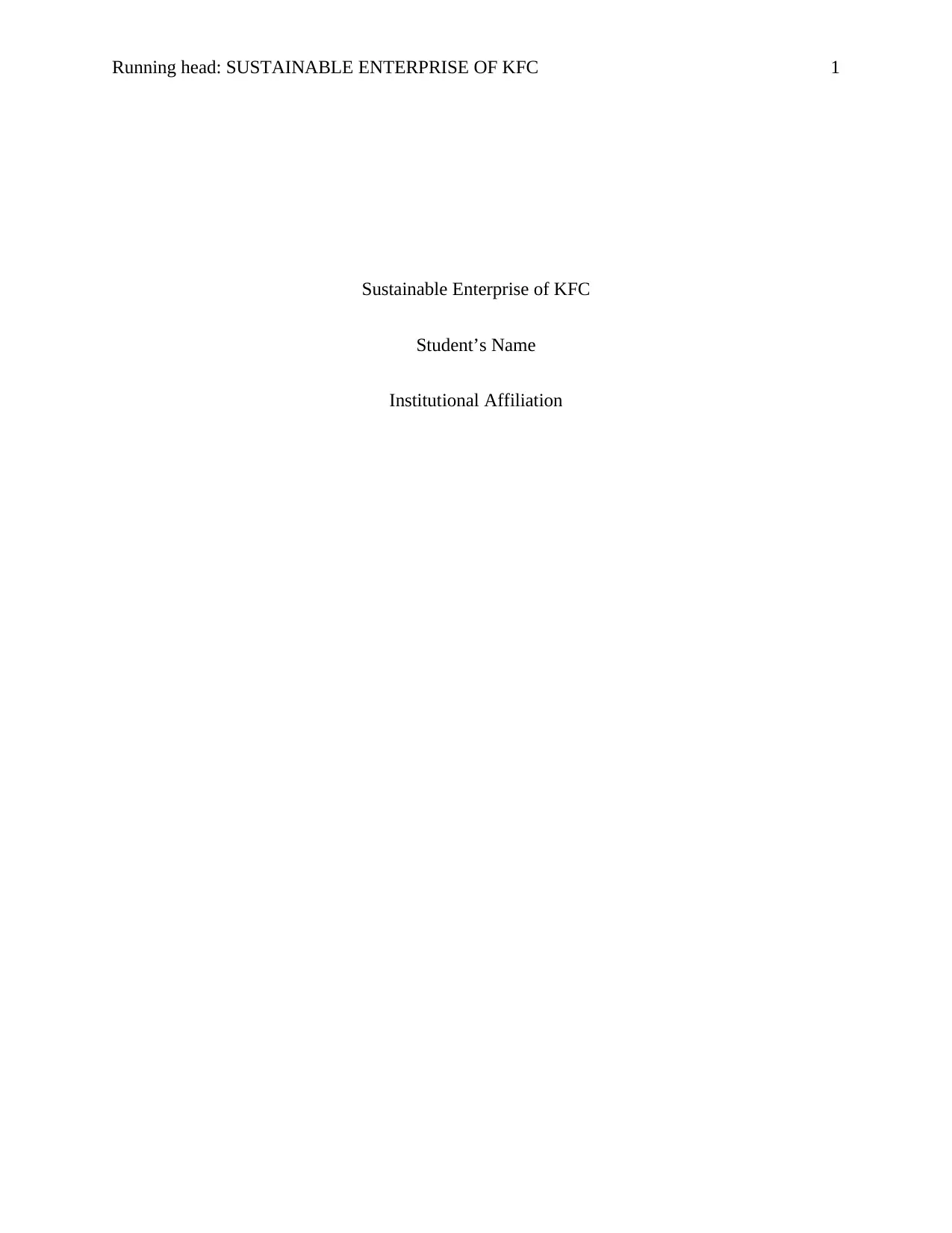
Running head: SUSTAINABLE ENTERPRISE OF KFC 1
Sustainable Enterprise of KFC
Student’s Name
Institutional Affiliation
Sustainable Enterprise of KFC
Student’s Name
Institutional Affiliation
Paraphrase This Document
Need a fresh take? Get an instant paraphrase of this document with our AI Paraphraser
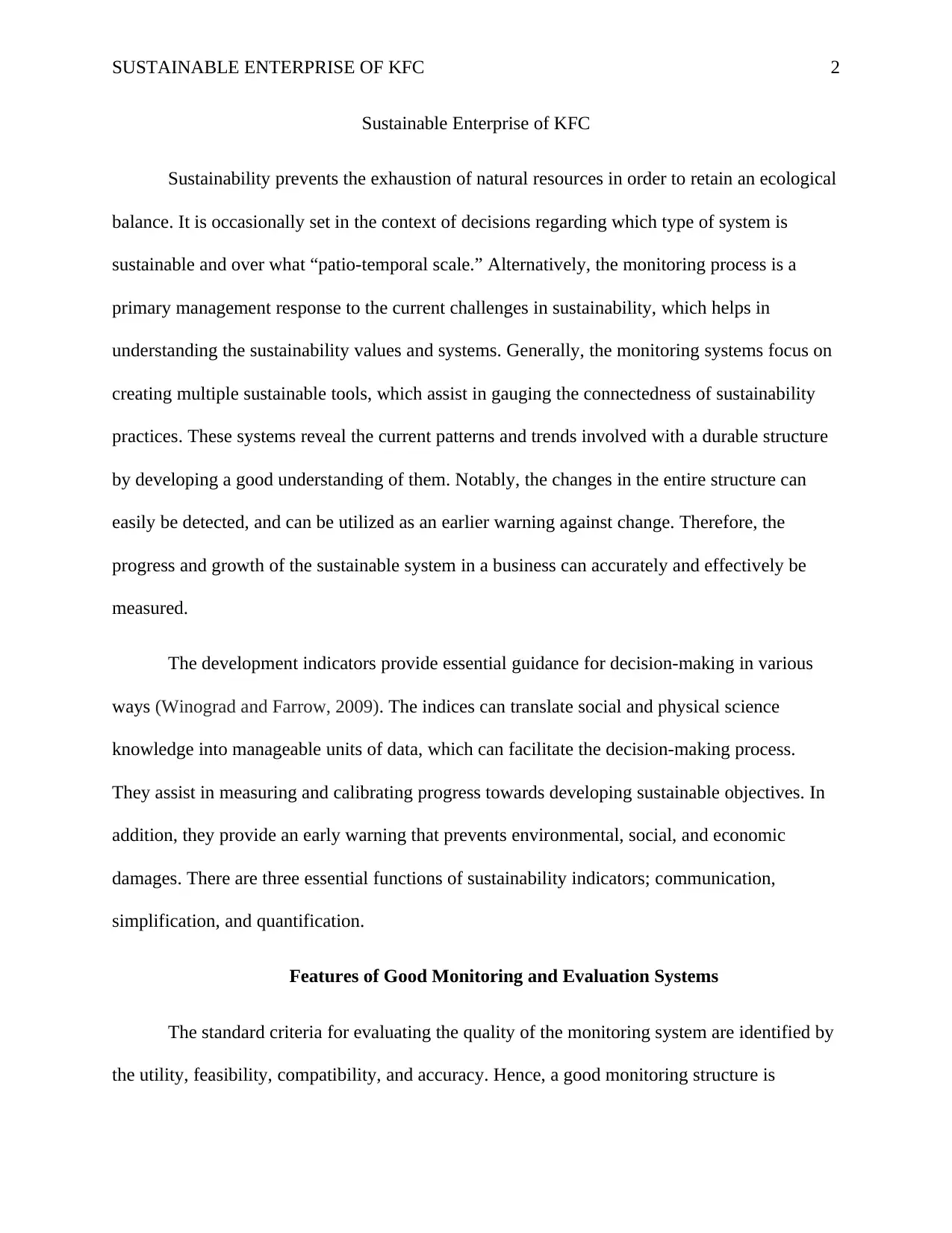
SUSTAINABLE ENTERPRISE OF KFC 2
Sustainable Enterprise of KFC
Sustainability prevents the exhaustion of natural resources in order to retain an ecological
balance. It is occasionally set in the context of decisions regarding which type of system is
sustainable and over what “patio-temporal scale.” Alternatively, the monitoring process is a
primary management response to the current challenges in sustainability, which helps in
understanding the sustainability values and systems. Generally, the monitoring systems focus on
creating multiple sustainable tools, which assist in gauging the connectedness of sustainability
practices. These systems reveal the current patterns and trends involved with a durable structure
by developing a good understanding of them. Notably, the changes in the entire structure can
easily be detected, and can be utilized as an earlier warning against change. Therefore, the
progress and growth of the sustainable system in a business can accurately and effectively be
measured.
The development indicators provide essential guidance for decision-making in various
ways (Winograd and Farrow, 2009). The indices can translate social and physical science
knowledge into manageable units of data, which can facilitate the decision-making process.
They assist in measuring and calibrating progress towards developing sustainable objectives. In
addition, they provide an early warning that prevents environmental, social, and economic
damages. There are three essential functions of sustainability indicators; communication,
simplification, and quantification.
Features of Good Monitoring and Evaluation Systems
The standard criteria for evaluating the quality of the monitoring system are identified by
the utility, feasibility, compatibility, and accuracy. Hence, a good monitoring structure is
Sustainable Enterprise of KFC
Sustainability prevents the exhaustion of natural resources in order to retain an ecological
balance. It is occasionally set in the context of decisions regarding which type of system is
sustainable and over what “patio-temporal scale.” Alternatively, the monitoring process is a
primary management response to the current challenges in sustainability, which helps in
understanding the sustainability values and systems. Generally, the monitoring systems focus on
creating multiple sustainable tools, which assist in gauging the connectedness of sustainability
practices. These systems reveal the current patterns and trends involved with a durable structure
by developing a good understanding of them. Notably, the changes in the entire structure can
easily be detected, and can be utilized as an earlier warning against change. Therefore, the
progress and growth of the sustainable system in a business can accurately and effectively be
measured.
The development indicators provide essential guidance for decision-making in various
ways (Winograd and Farrow, 2009). The indices can translate social and physical science
knowledge into manageable units of data, which can facilitate the decision-making process.
They assist in measuring and calibrating progress towards developing sustainable objectives. In
addition, they provide an early warning that prevents environmental, social, and economic
damages. There are three essential functions of sustainability indicators; communication,
simplification, and quantification.
Features of Good Monitoring and Evaluation Systems
The standard criteria for evaluating the quality of the monitoring system are identified by
the utility, feasibility, compatibility, and accuracy. Hence, a good monitoring structure is
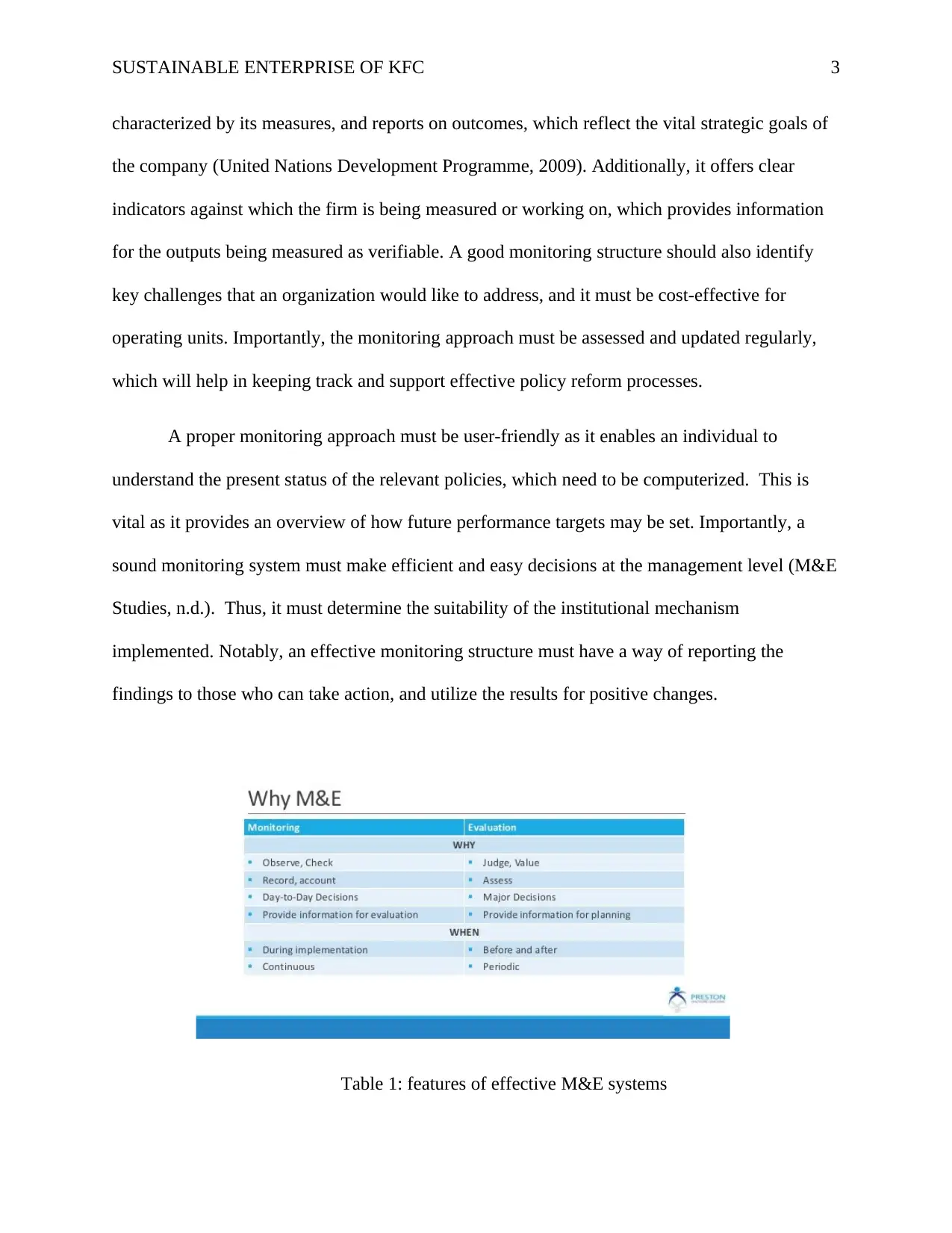
SUSTAINABLE ENTERPRISE OF KFC 3
characterized by its measures, and reports on outcomes, which reflect the vital strategic goals of
the company (United Nations Development Programme, 2009). Additionally, it offers clear
indicators against which the firm is being measured or working on, which provides information
for the outputs being measured as verifiable. A good monitoring structure should also identify
key challenges that an organization would like to address, and it must be cost-effective for
operating units. Importantly, the monitoring approach must be assessed and updated regularly,
which will help in keeping track and support effective policy reform processes.
A proper monitoring approach must be user-friendly as it enables an individual to
understand the present status of the relevant policies, which need to be computerized. This is
vital as it provides an overview of how future performance targets may be set. Importantly, a
sound monitoring system must make efficient and easy decisions at the management level (M&E
Studies, n.d.). Thus, it must determine the suitability of the institutional mechanism
implemented. Notably, an effective monitoring structure must have a way of reporting the
findings to those who can take action, and utilize the results for positive changes.
Table 1: features of effective M&E systems
characterized by its measures, and reports on outcomes, which reflect the vital strategic goals of
the company (United Nations Development Programme, 2009). Additionally, it offers clear
indicators against which the firm is being measured or working on, which provides information
for the outputs being measured as verifiable. A good monitoring structure should also identify
key challenges that an organization would like to address, and it must be cost-effective for
operating units. Importantly, the monitoring approach must be assessed and updated regularly,
which will help in keeping track and support effective policy reform processes.
A proper monitoring approach must be user-friendly as it enables an individual to
understand the present status of the relevant policies, which need to be computerized. This is
vital as it provides an overview of how future performance targets may be set. Importantly, a
sound monitoring system must make efficient and easy decisions at the management level (M&E
Studies, n.d.). Thus, it must determine the suitability of the institutional mechanism
implemented. Notably, an effective monitoring structure must have a way of reporting the
findings to those who can take action, and utilize the results for positive changes.
Table 1: features of effective M&E systems
⊘ This is a preview!⊘
Do you want full access?
Subscribe today to unlock all pages.

Trusted by 1+ million students worldwide
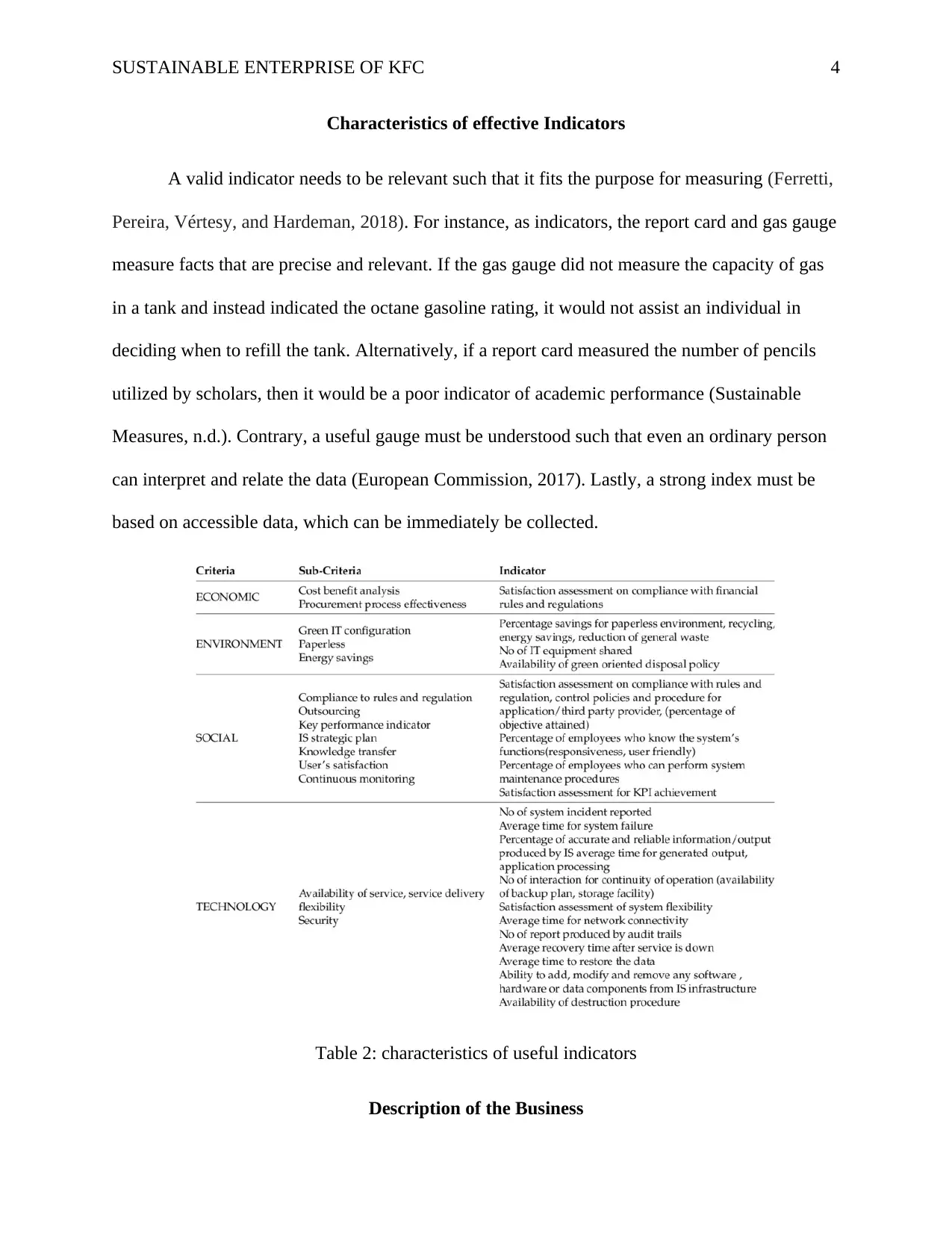
SUSTAINABLE ENTERPRISE OF KFC 4
Characteristics of effective Indicators
A valid indicator needs to be relevant such that it fits the purpose for measuring (Ferretti,
Pereira, Vértesy, and Hardeman, 2018). For instance, as indicators, the report card and gas gauge
measure facts that are precise and relevant. If the gas gauge did not measure the capacity of gas
in a tank and instead indicated the octane gasoline rating, it would not assist an individual in
deciding when to refill the tank. Alternatively, if a report card measured the number of pencils
utilized by scholars, then it would be a poor indicator of academic performance (Sustainable
Measures, n.d.). Contrary, a useful gauge must be understood such that even an ordinary person
can interpret and relate the data (European Commission, 2017). Lastly, a strong index must be
based on accessible data, which can be immediately be collected.
Table 2: characteristics of useful indicators
Description of the Business
Characteristics of effective Indicators
A valid indicator needs to be relevant such that it fits the purpose for measuring (Ferretti,
Pereira, Vértesy, and Hardeman, 2018). For instance, as indicators, the report card and gas gauge
measure facts that are precise and relevant. If the gas gauge did not measure the capacity of gas
in a tank and instead indicated the octane gasoline rating, it would not assist an individual in
deciding when to refill the tank. Alternatively, if a report card measured the number of pencils
utilized by scholars, then it would be a poor indicator of academic performance (Sustainable
Measures, n.d.). Contrary, a useful gauge must be understood such that even an ordinary person
can interpret and relate the data (European Commission, 2017). Lastly, a strong index must be
based on accessible data, which can be immediately be collected.
Table 2: characteristics of useful indicators
Description of the Business
Paraphrase This Document
Need a fresh take? Get an instant paraphrase of this document with our AI Paraphraser
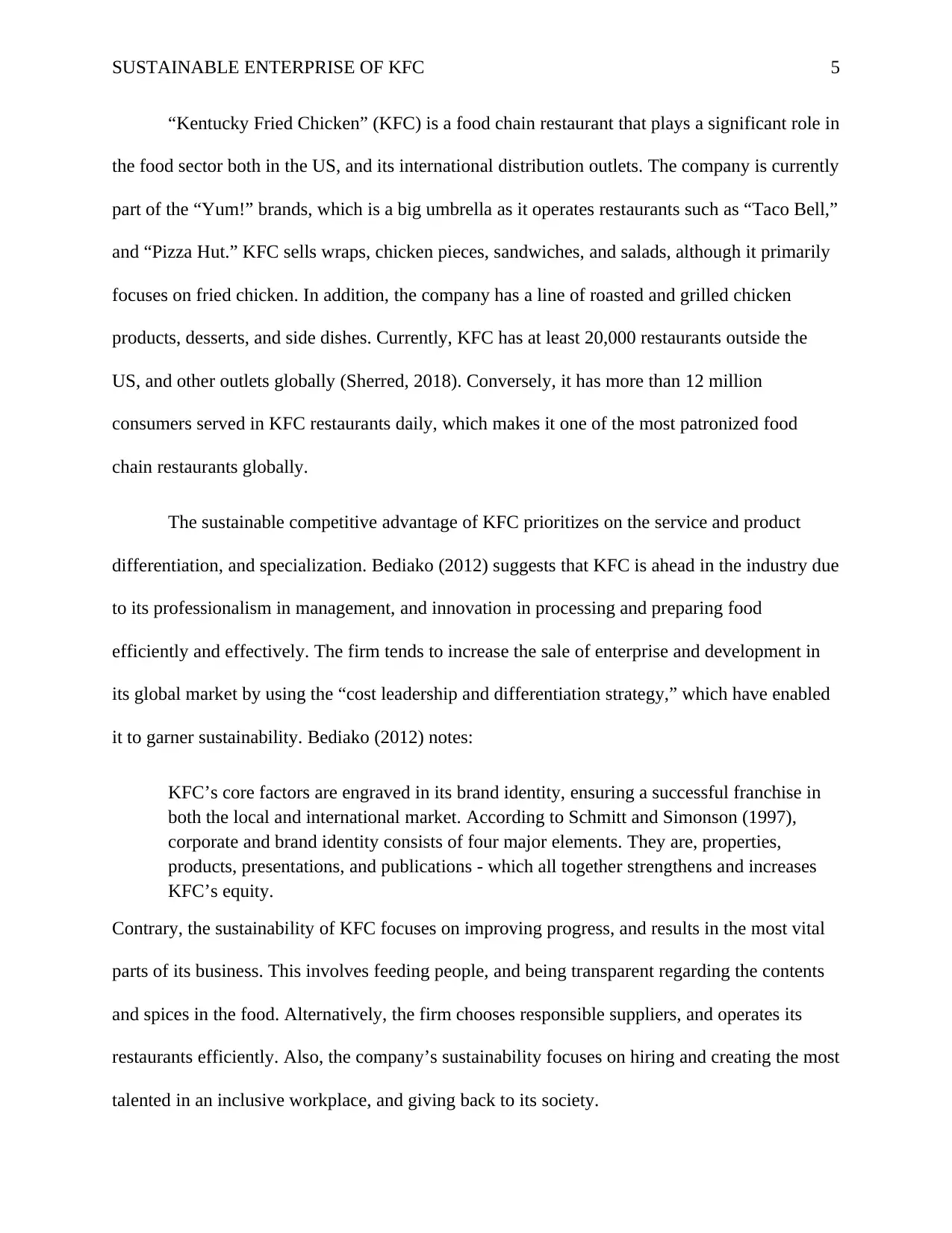
SUSTAINABLE ENTERPRISE OF KFC 5
“Kentucky Fried Chicken” (KFC) is a food chain restaurant that plays a significant role in
the food sector both in the US, and its international distribution outlets. The company is currently
part of the “Yum!” brands, which is a big umbrella as it operates restaurants such as “Taco Bell,”
and “Pizza Hut.” KFC sells wraps, chicken pieces, sandwiches, and salads, although it primarily
focuses on fried chicken. In addition, the company has a line of roasted and grilled chicken
products, desserts, and side dishes. Currently, KFC has at least 20,000 restaurants outside the
US, and other outlets globally (Sherred, 2018). Conversely, it has more than 12 million
consumers served in KFC restaurants daily, which makes it one of the most patronized food
chain restaurants globally.
The sustainable competitive advantage of KFC prioritizes on the service and product
differentiation, and specialization. Bediako (2012) suggests that KFC is ahead in the industry due
to its professionalism in management, and innovation in processing and preparing food
efficiently and effectively. The firm tends to increase the sale of enterprise and development in
its global market by using the “cost leadership and differentiation strategy,” which have enabled
it to garner sustainability. Bediako (2012) notes:
KFC’s core factors are engraved in its brand identity, ensuring a successful franchise in
both the local and international market. According to Schmitt and Simonson (1997),
corporate and brand identity consists of four major elements. They are, properties,
products, presentations, and publications - which all together strengthens and increases
KFC’s equity.
Contrary, the sustainability of KFC focuses on improving progress, and results in the most vital
parts of its business. This involves feeding people, and being transparent regarding the contents
and spices in the food. Alternatively, the firm chooses responsible suppliers, and operates its
restaurants efficiently. Also, the company’s sustainability focuses on hiring and creating the most
talented in an inclusive workplace, and giving back to its society.
“Kentucky Fried Chicken” (KFC) is a food chain restaurant that plays a significant role in
the food sector both in the US, and its international distribution outlets. The company is currently
part of the “Yum!” brands, which is a big umbrella as it operates restaurants such as “Taco Bell,”
and “Pizza Hut.” KFC sells wraps, chicken pieces, sandwiches, and salads, although it primarily
focuses on fried chicken. In addition, the company has a line of roasted and grilled chicken
products, desserts, and side dishes. Currently, KFC has at least 20,000 restaurants outside the
US, and other outlets globally (Sherred, 2018). Conversely, it has more than 12 million
consumers served in KFC restaurants daily, which makes it one of the most patronized food
chain restaurants globally.
The sustainable competitive advantage of KFC prioritizes on the service and product
differentiation, and specialization. Bediako (2012) suggests that KFC is ahead in the industry due
to its professionalism in management, and innovation in processing and preparing food
efficiently and effectively. The firm tends to increase the sale of enterprise and development in
its global market by using the “cost leadership and differentiation strategy,” which have enabled
it to garner sustainability. Bediako (2012) notes:
KFC’s core factors are engraved in its brand identity, ensuring a successful franchise in
both the local and international market. According to Schmitt and Simonson (1997),
corporate and brand identity consists of four major elements. They are, properties,
products, presentations, and publications - which all together strengthens and increases
KFC’s equity.
Contrary, the sustainability of KFC focuses on improving progress, and results in the most vital
parts of its business. This involves feeding people, and being transparent regarding the contents
and spices in the food. Alternatively, the firm chooses responsible suppliers, and operates its
restaurants efficiently. Also, the company’s sustainability focuses on hiring and creating the most
talented in an inclusive workplace, and giving back to its society.
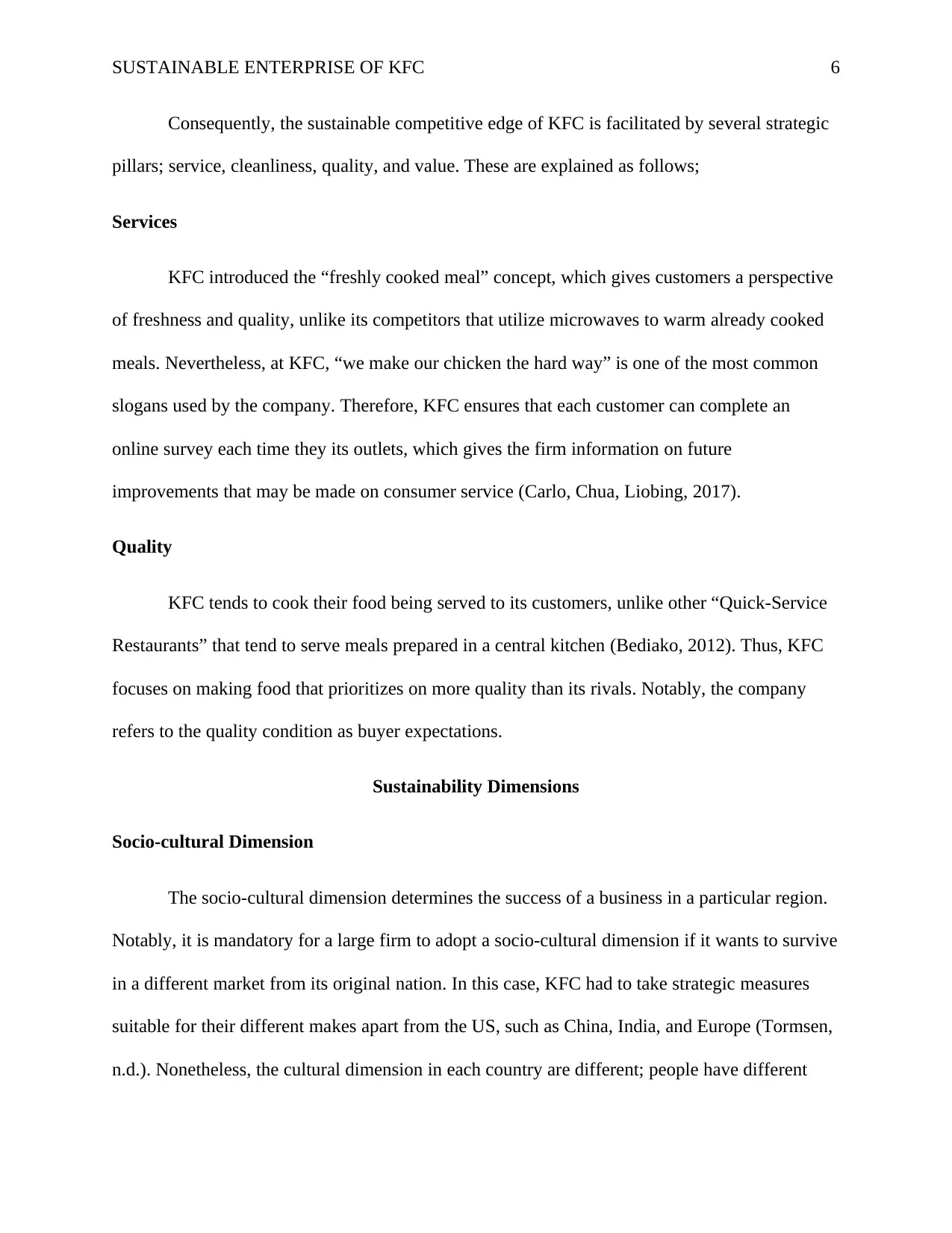
SUSTAINABLE ENTERPRISE OF KFC 6
Consequently, the sustainable competitive edge of KFC is facilitated by several strategic
pillars; service, cleanliness, quality, and value. These are explained as follows;
Services
KFC introduced the “freshly cooked meal” concept, which gives customers a perspective
of freshness and quality, unlike its competitors that utilize microwaves to warm already cooked
meals. Nevertheless, at KFC, “we make our chicken the hard way” is one of the most common
slogans used by the company. Therefore, KFC ensures that each customer can complete an
online survey each time they its outlets, which gives the firm information on future
improvements that may be made on consumer service (Carlo, Chua, Liobing, 2017).
Quality
KFC tends to cook their food being served to its customers, unlike other “Quick-Service
Restaurants” that tend to serve meals prepared in a central kitchen (Bediako, 2012). Thus, KFC
focuses on making food that prioritizes on more quality than its rivals. Notably, the company
refers to the quality condition as buyer expectations.
Sustainability Dimensions
Socio-cultural Dimension
The socio-cultural dimension determines the success of a business in a particular region.
Notably, it is mandatory for a large firm to adopt a socio-cultural dimension if it wants to survive
in a different market from its original nation. In this case, KFC had to take strategic measures
suitable for their different makes apart from the US, such as China, India, and Europe (Tormsen,
n.d.). Nonetheless, the cultural dimension in each country are different; people have different
Consequently, the sustainable competitive edge of KFC is facilitated by several strategic
pillars; service, cleanliness, quality, and value. These are explained as follows;
Services
KFC introduced the “freshly cooked meal” concept, which gives customers a perspective
of freshness and quality, unlike its competitors that utilize microwaves to warm already cooked
meals. Nevertheless, at KFC, “we make our chicken the hard way” is one of the most common
slogans used by the company. Therefore, KFC ensures that each customer can complete an
online survey each time they its outlets, which gives the firm information on future
improvements that may be made on consumer service (Carlo, Chua, Liobing, 2017).
Quality
KFC tends to cook their food being served to its customers, unlike other “Quick-Service
Restaurants” that tend to serve meals prepared in a central kitchen (Bediako, 2012). Thus, KFC
focuses on making food that prioritizes on more quality than its rivals. Notably, the company
refers to the quality condition as buyer expectations.
Sustainability Dimensions
Socio-cultural Dimension
The socio-cultural dimension determines the success of a business in a particular region.
Notably, it is mandatory for a large firm to adopt a socio-cultural dimension if it wants to survive
in a different market from its original nation. In this case, KFC had to take strategic measures
suitable for their different makes apart from the US, such as China, India, and Europe (Tormsen,
n.d.). Nonetheless, the cultural dimension in each country are different; people have different
⊘ This is a preview!⊘
Do you want full access?
Subscribe today to unlock all pages.

Trusted by 1+ million students worldwide
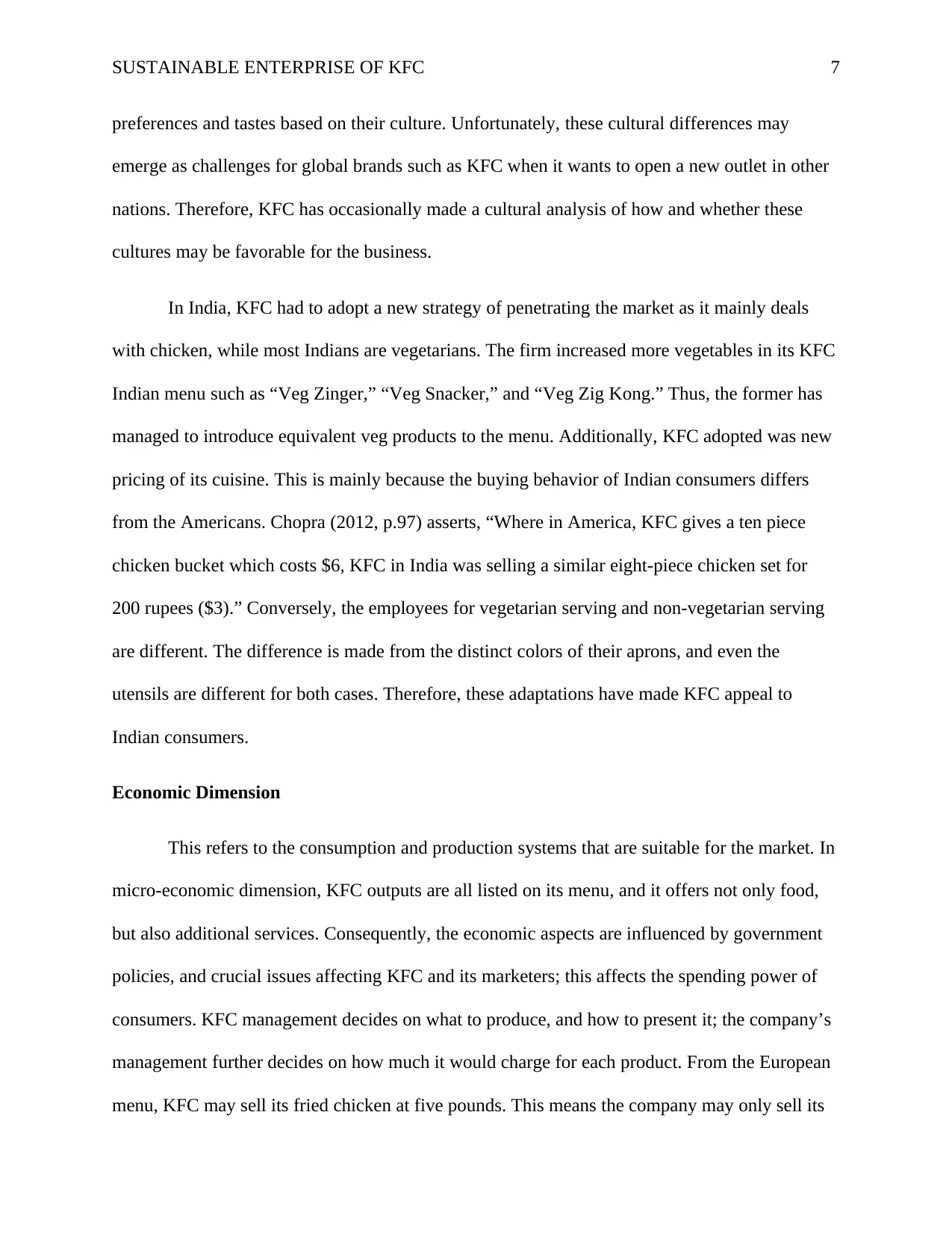
SUSTAINABLE ENTERPRISE OF KFC 7
preferences and tastes based on their culture. Unfortunately, these cultural differences may
emerge as challenges for global brands such as KFC when it wants to open a new outlet in other
nations. Therefore, KFC has occasionally made a cultural analysis of how and whether these
cultures may be favorable for the business.
In India, KFC had to adopt a new strategy of penetrating the market as it mainly deals
with chicken, while most Indians are vegetarians. The firm increased more vegetables in its KFC
Indian menu such as “Veg Zinger,” “Veg Snacker,” and “Veg Zig Kong.” Thus, the former has
managed to introduce equivalent veg products to the menu. Additionally, KFC adopted was new
pricing of its cuisine. This is mainly because the buying behavior of Indian consumers differs
from the Americans. Chopra (2012, p.97) asserts, “Where in America, KFC gives a ten piece
chicken bucket which costs $6, KFC in India was selling a similar eight-piece chicken set for
200 rupees ($3).” Conversely, the employees for vegetarian serving and non-vegetarian serving
are different. The difference is made from the distinct colors of their aprons, and even the
utensils are different for both cases. Therefore, these adaptations have made KFC appeal to
Indian consumers.
Economic Dimension
This refers to the consumption and production systems that are suitable for the market. In
micro-economic dimension, KFC outputs are all listed on its menu, and it offers not only food,
but also additional services. Consequently, the economic aspects are influenced by government
policies, and crucial issues affecting KFC and its marketers; this affects the spending power of
consumers. KFC management decides on what to produce, and how to present it; the company’s
management further decides on how much it would charge for each product. From the European
menu, KFC may sell its fried chicken at five pounds. This means the company may only sell its
preferences and tastes based on their culture. Unfortunately, these cultural differences may
emerge as challenges for global brands such as KFC when it wants to open a new outlet in other
nations. Therefore, KFC has occasionally made a cultural analysis of how and whether these
cultures may be favorable for the business.
In India, KFC had to adopt a new strategy of penetrating the market as it mainly deals
with chicken, while most Indians are vegetarians. The firm increased more vegetables in its KFC
Indian menu such as “Veg Zinger,” “Veg Snacker,” and “Veg Zig Kong.” Thus, the former has
managed to introduce equivalent veg products to the menu. Additionally, KFC adopted was new
pricing of its cuisine. This is mainly because the buying behavior of Indian consumers differs
from the Americans. Chopra (2012, p.97) asserts, “Where in America, KFC gives a ten piece
chicken bucket which costs $6, KFC in India was selling a similar eight-piece chicken set for
200 rupees ($3).” Conversely, the employees for vegetarian serving and non-vegetarian serving
are different. The difference is made from the distinct colors of their aprons, and even the
utensils are different for both cases. Therefore, these adaptations have made KFC appeal to
Indian consumers.
Economic Dimension
This refers to the consumption and production systems that are suitable for the market. In
micro-economic dimension, KFC outputs are all listed on its menu, and it offers not only food,
but also additional services. Consequently, the economic aspects are influenced by government
policies, and crucial issues affecting KFC and its marketers; this affects the spending power of
consumers. KFC management decides on what to produce, and how to present it; the company’s
management further decides on how much it would charge for each product. From the European
menu, KFC may sell its fried chicken at five pounds. This means the company may only sell its
Paraphrase This Document
Need a fresh take? Get an instant paraphrase of this document with our AI Paraphraser
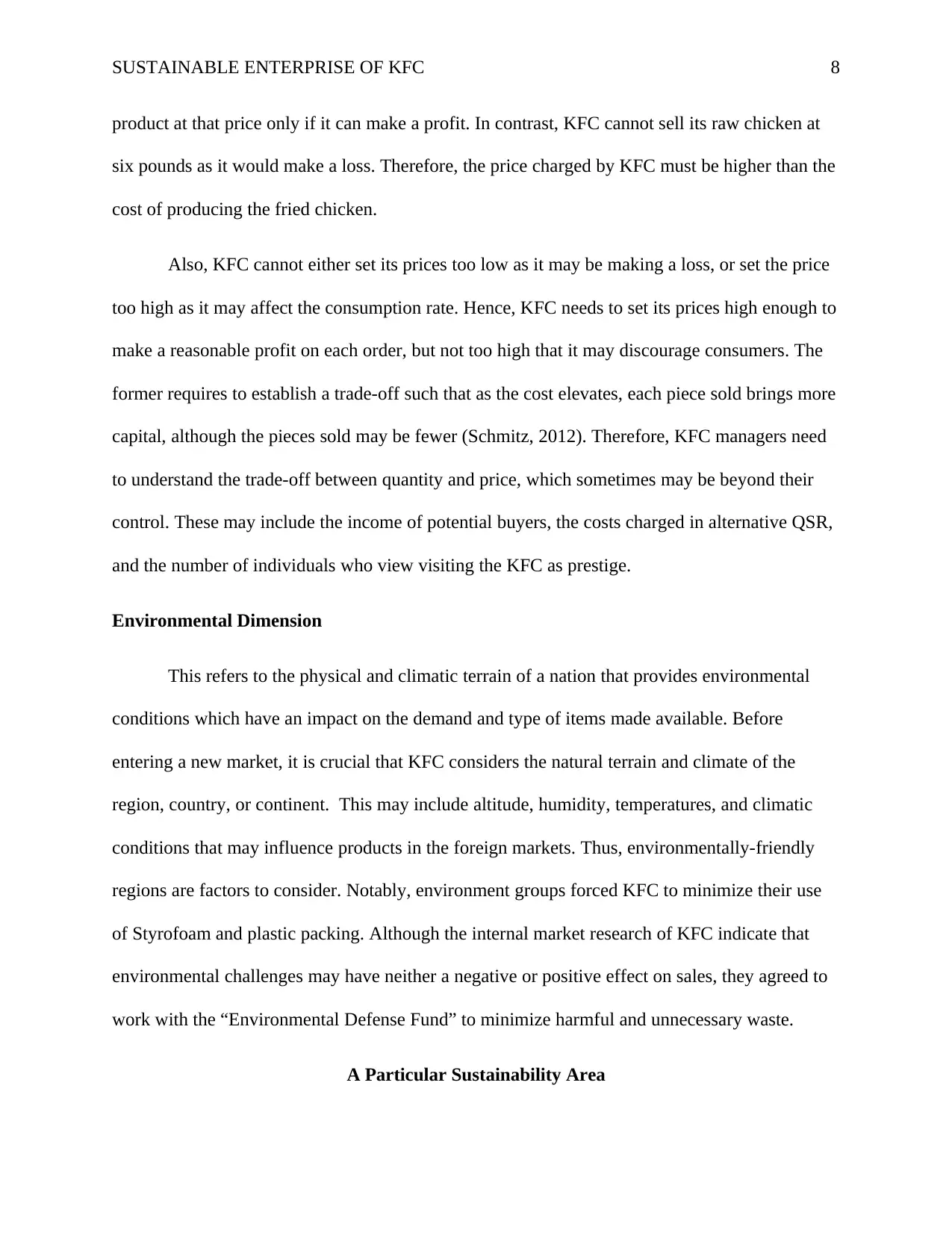
SUSTAINABLE ENTERPRISE OF KFC 8
product at that price only if it can make a profit. In contrast, KFC cannot sell its raw chicken at
six pounds as it would make a loss. Therefore, the price charged by KFC must be higher than the
cost of producing the fried chicken.
Also, KFC cannot either set its prices too low as it may be making a loss, or set the price
too high as it may affect the consumption rate. Hence, KFC needs to set its prices high enough to
make a reasonable profit on each order, but not too high that it may discourage consumers. The
former requires to establish a trade-off such that as the cost elevates, each piece sold brings more
capital, although the pieces sold may be fewer (Schmitz, 2012). Therefore, KFC managers need
to understand the trade-off between quantity and price, which sometimes may be beyond their
control. These may include the income of potential buyers, the costs charged in alternative QSR,
and the number of individuals who view visiting the KFC as prestige.
Environmental Dimension
This refers to the physical and climatic terrain of a nation that provides environmental
conditions which have an impact on the demand and type of items made available. Before
entering a new market, it is crucial that KFC considers the natural terrain and climate of the
region, country, or continent. This may include altitude, humidity, temperatures, and climatic
conditions that may influence products in the foreign markets. Thus, environmentally-friendly
regions are factors to consider. Notably, environment groups forced KFC to minimize their use
of Styrofoam and plastic packing. Although the internal market research of KFC indicate that
environmental challenges may have neither a negative or positive effect on sales, they agreed to
work with the “Environmental Defense Fund” to minimize harmful and unnecessary waste.
A Particular Sustainability Area
product at that price only if it can make a profit. In contrast, KFC cannot sell its raw chicken at
six pounds as it would make a loss. Therefore, the price charged by KFC must be higher than the
cost of producing the fried chicken.
Also, KFC cannot either set its prices too low as it may be making a loss, or set the price
too high as it may affect the consumption rate. Hence, KFC needs to set its prices high enough to
make a reasonable profit on each order, but not too high that it may discourage consumers. The
former requires to establish a trade-off such that as the cost elevates, each piece sold brings more
capital, although the pieces sold may be fewer (Schmitz, 2012). Therefore, KFC managers need
to understand the trade-off between quantity and price, which sometimes may be beyond their
control. These may include the income of potential buyers, the costs charged in alternative QSR,
and the number of individuals who view visiting the KFC as prestige.
Environmental Dimension
This refers to the physical and climatic terrain of a nation that provides environmental
conditions which have an impact on the demand and type of items made available. Before
entering a new market, it is crucial that KFC considers the natural terrain and climate of the
region, country, or continent. This may include altitude, humidity, temperatures, and climatic
conditions that may influence products in the foreign markets. Thus, environmentally-friendly
regions are factors to consider. Notably, environment groups forced KFC to minimize their use
of Styrofoam and plastic packing. Although the internal market research of KFC indicate that
environmental challenges may have neither a negative or positive effect on sales, they agreed to
work with the “Environmental Defense Fund” to minimize harmful and unnecessary waste.
A Particular Sustainability Area
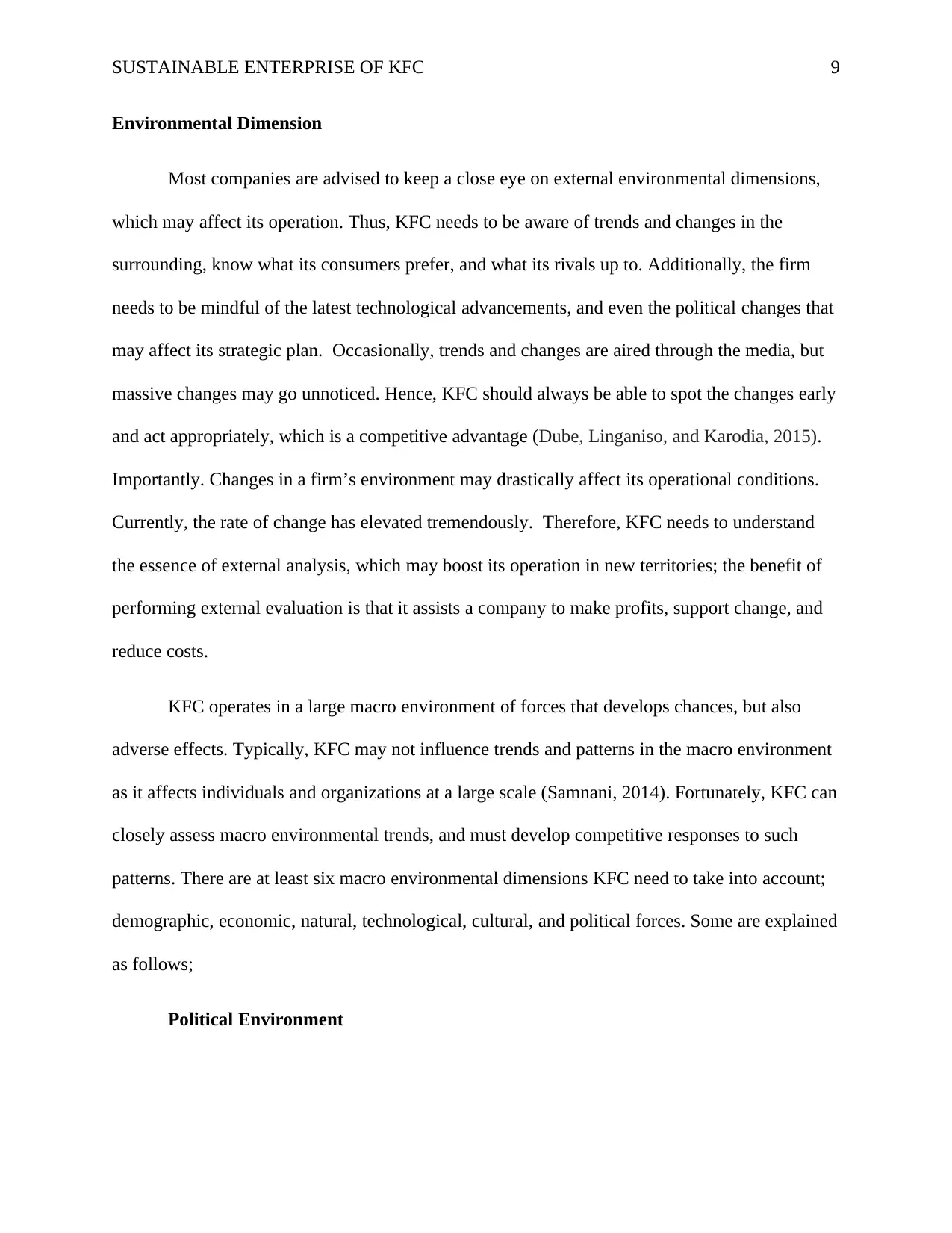
SUSTAINABLE ENTERPRISE OF KFC 9
Environmental Dimension
Most companies are advised to keep a close eye on external environmental dimensions,
which may affect its operation. Thus, KFC needs to be aware of trends and changes in the
surrounding, know what its consumers prefer, and what its rivals up to. Additionally, the firm
needs to be mindful of the latest technological advancements, and even the political changes that
may affect its strategic plan. Occasionally, trends and changes are aired through the media, but
massive changes may go unnoticed. Hence, KFC should always be able to spot the changes early
and act appropriately, which is a competitive advantage (Dube, Linganiso, and Karodia, 2015).
Importantly. Changes in a firm’s environment may drastically affect its operational conditions.
Currently, the rate of change has elevated tremendously. Therefore, KFC needs to understand
the essence of external analysis, which may boost its operation in new territories; the benefit of
performing external evaluation is that it assists a company to make profits, support change, and
reduce costs.
KFC operates in a large macro environment of forces that develops chances, but also
adverse effects. Typically, KFC may not influence trends and patterns in the macro environment
as it affects individuals and organizations at a large scale (Samnani, 2014). Fortunately, KFC can
closely assess macro environmental trends, and must develop competitive responses to such
patterns. There are at least six macro environmental dimensions KFC need to take into account;
demographic, economic, natural, technological, cultural, and political forces. Some are explained
as follows;
Political Environment
Environmental Dimension
Most companies are advised to keep a close eye on external environmental dimensions,
which may affect its operation. Thus, KFC needs to be aware of trends and changes in the
surrounding, know what its consumers prefer, and what its rivals up to. Additionally, the firm
needs to be mindful of the latest technological advancements, and even the political changes that
may affect its strategic plan. Occasionally, trends and changes are aired through the media, but
massive changes may go unnoticed. Hence, KFC should always be able to spot the changes early
and act appropriately, which is a competitive advantage (Dube, Linganiso, and Karodia, 2015).
Importantly. Changes in a firm’s environment may drastically affect its operational conditions.
Currently, the rate of change has elevated tremendously. Therefore, KFC needs to understand
the essence of external analysis, which may boost its operation in new territories; the benefit of
performing external evaluation is that it assists a company to make profits, support change, and
reduce costs.
KFC operates in a large macro environment of forces that develops chances, but also
adverse effects. Typically, KFC may not influence trends and patterns in the macro environment
as it affects individuals and organizations at a large scale (Samnani, 2014). Fortunately, KFC can
closely assess macro environmental trends, and must develop competitive responses to such
patterns. There are at least six macro environmental dimensions KFC need to take into account;
demographic, economic, natural, technological, cultural, and political forces. Some are explained
as follows;
Political Environment
⊘ This is a preview!⊘
Do you want full access?
Subscribe today to unlock all pages.

Trusted by 1+ million students worldwide
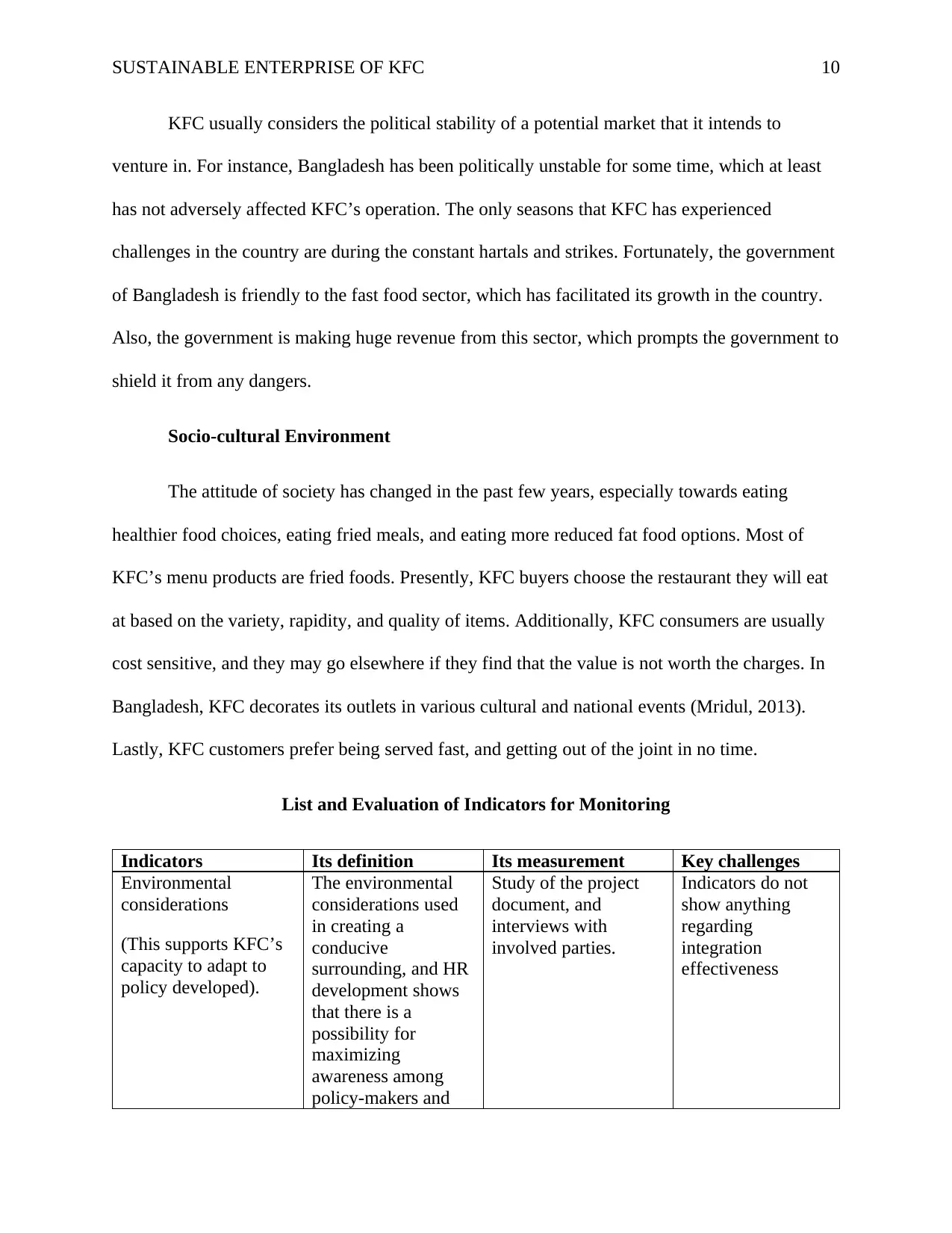
SUSTAINABLE ENTERPRISE OF KFC 10
KFC usually considers the political stability of a potential market that it intends to
venture in. For instance, Bangladesh has been politically unstable for some time, which at least
has not adversely affected KFC’s operation. The only seasons that KFC has experienced
challenges in the country are during the constant hartals and strikes. Fortunately, the government
of Bangladesh is friendly to the fast food sector, which has facilitated its growth in the country.
Also, the government is making huge revenue from this sector, which prompts the government to
shield it from any dangers.
Socio-cultural Environment
The attitude of society has changed in the past few years, especially towards eating
healthier food choices, eating fried meals, and eating more reduced fat food options. Most of
KFC’s menu products are fried foods. Presently, KFC buyers choose the restaurant they will eat
at based on the variety, rapidity, and quality of items. Additionally, KFC consumers are usually
cost sensitive, and they may go elsewhere if they find that the value is not worth the charges. In
Bangladesh, KFC decorates its outlets in various cultural and national events (Mridul, 2013).
Lastly, KFC customers prefer being served fast, and getting out of the joint in no time.
List and Evaluation of Indicators for Monitoring
Indicators Its definition Its measurement Key challenges
Environmental
considerations
(This supports KFC’s
capacity to adapt to
policy developed).
The environmental
considerations used
in creating a
conducive
surrounding, and HR
development shows
that there is a
possibility for
maximizing
awareness among
policy-makers and
Study of the project
document, and
interviews with
involved parties.
Indicators do not
show anything
regarding
integration
effectiveness
KFC usually considers the political stability of a potential market that it intends to
venture in. For instance, Bangladesh has been politically unstable for some time, which at least
has not adversely affected KFC’s operation. The only seasons that KFC has experienced
challenges in the country are during the constant hartals and strikes. Fortunately, the government
of Bangladesh is friendly to the fast food sector, which has facilitated its growth in the country.
Also, the government is making huge revenue from this sector, which prompts the government to
shield it from any dangers.
Socio-cultural Environment
The attitude of society has changed in the past few years, especially towards eating
healthier food choices, eating fried meals, and eating more reduced fat food options. Most of
KFC’s menu products are fried foods. Presently, KFC buyers choose the restaurant they will eat
at based on the variety, rapidity, and quality of items. Additionally, KFC consumers are usually
cost sensitive, and they may go elsewhere if they find that the value is not worth the charges. In
Bangladesh, KFC decorates its outlets in various cultural and national events (Mridul, 2013).
Lastly, KFC customers prefer being served fast, and getting out of the joint in no time.
List and Evaluation of Indicators for Monitoring
Indicators Its definition Its measurement Key challenges
Environmental
considerations
(This supports KFC’s
capacity to adapt to
policy developed).
The environmental
considerations used
in creating a
conducive
surrounding, and HR
development shows
that there is a
possibility for
maximizing
awareness among
policy-makers and
Study of the project
document, and
interviews with
involved parties.
Indicators do not
show anything
regarding
integration
effectiveness
Paraphrase This Document
Need a fresh take? Get an instant paraphrase of this document with our AI Paraphraser
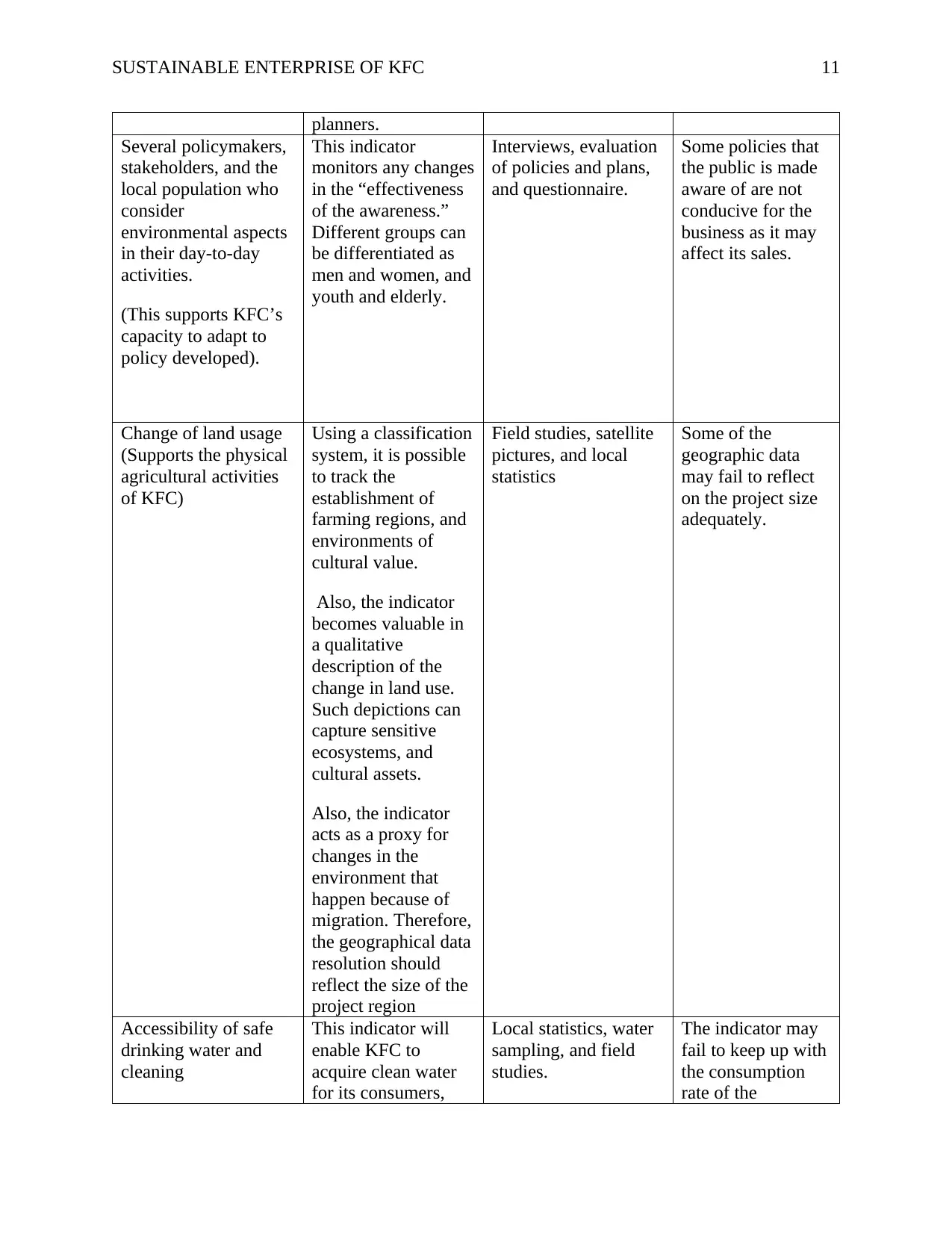
SUSTAINABLE ENTERPRISE OF KFC 11
planners.
Several policymakers,
stakeholders, and the
local population who
consider
environmental aspects
in their day-to-day
activities.
(This supports KFC’s
capacity to adapt to
policy developed).
This indicator
monitors any changes
in the “effectiveness
of the awareness.”
Different groups can
be differentiated as
men and women, and
youth and elderly.
Interviews, evaluation
of policies and plans,
and questionnaire.
Some policies that
the public is made
aware of are not
conducive for the
business as it may
affect its sales.
Change of land usage
(Supports the physical
agricultural activities
of KFC)
Using a classification
system, it is possible
to track the
establishment of
farming regions, and
environments of
cultural value.
Also, the indicator
becomes valuable in
a qualitative
description of the
change in land use.
Such depictions can
capture sensitive
ecosystems, and
cultural assets.
Also, the indicator
acts as a proxy for
changes in the
environment that
happen because of
migration. Therefore,
the geographical data
resolution should
reflect the size of the
project region
Field studies, satellite
pictures, and local
statistics
Some of the
geographic data
may fail to reflect
on the project size
adequately.
Accessibility of safe
drinking water and
cleaning
This indicator will
enable KFC to
acquire clean water
for its consumers,
Local statistics, water
sampling, and field
studies.
The indicator may
fail to keep up with
the consumption
rate of the
planners.
Several policymakers,
stakeholders, and the
local population who
consider
environmental aspects
in their day-to-day
activities.
(This supports KFC’s
capacity to adapt to
policy developed).
This indicator
monitors any changes
in the “effectiveness
of the awareness.”
Different groups can
be differentiated as
men and women, and
youth and elderly.
Interviews, evaluation
of policies and plans,
and questionnaire.
Some policies that
the public is made
aware of are not
conducive for the
business as it may
affect its sales.
Change of land usage
(Supports the physical
agricultural activities
of KFC)
Using a classification
system, it is possible
to track the
establishment of
farming regions, and
environments of
cultural value.
Also, the indicator
becomes valuable in
a qualitative
description of the
change in land use.
Such depictions can
capture sensitive
ecosystems, and
cultural assets.
Also, the indicator
acts as a proxy for
changes in the
environment that
happen because of
migration. Therefore,
the geographical data
resolution should
reflect the size of the
project region
Field studies, satellite
pictures, and local
statistics
Some of the
geographic data
may fail to reflect
on the project size
adequately.
Accessibility of safe
drinking water and
cleaning
This indicator will
enable KFC to
acquire clean water
for its consumers,
Local statistics, water
sampling, and field
studies.
The indicator may
fail to keep up with
the consumption
rate of the
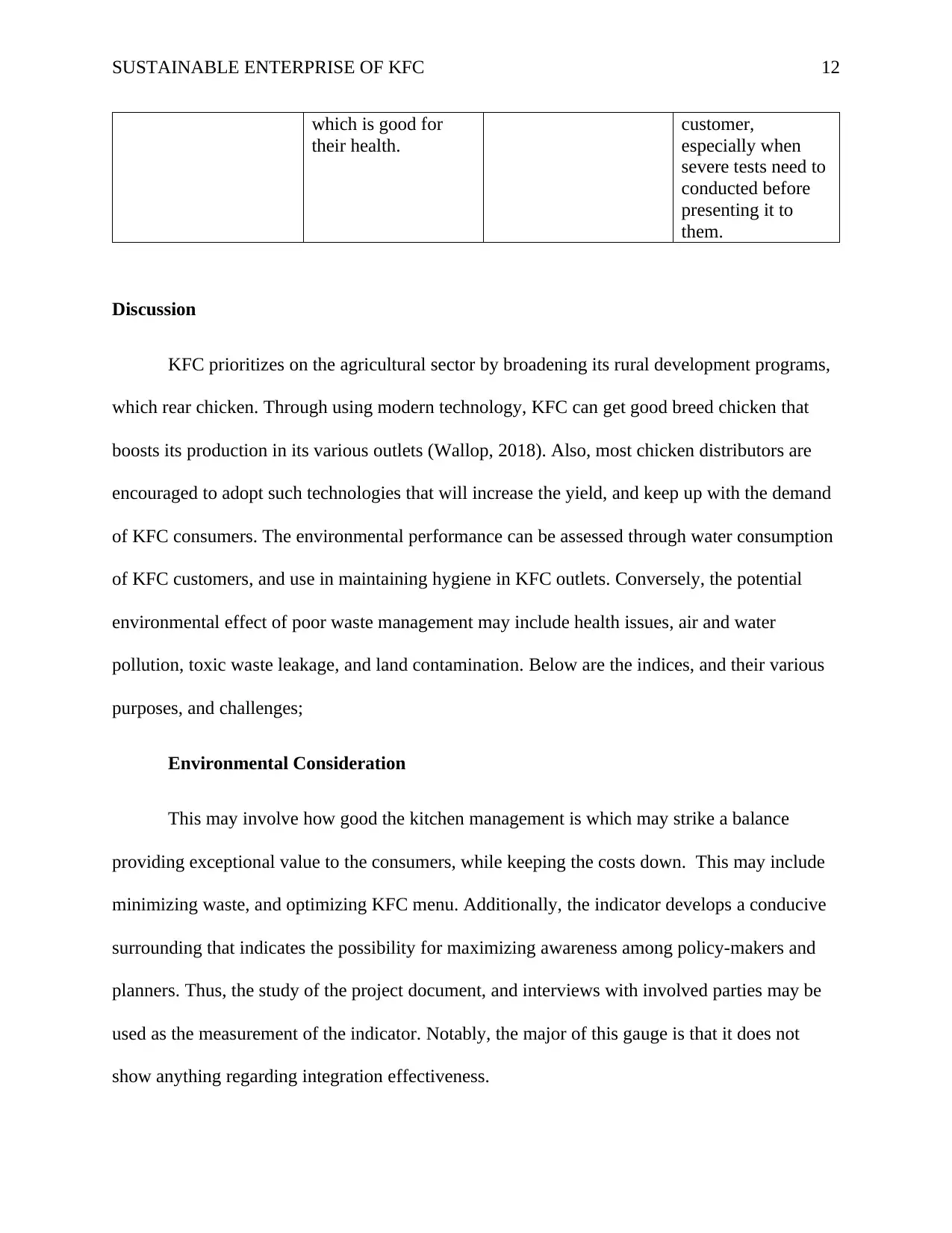
SUSTAINABLE ENTERPRISE OF KFC 12
which is good for
their health.
customer,
especially when
severe tests need to
conducted before
presenting it to
them.
Discussion
KFC prioritizes on the agricultural sector by broadening its rural development programs,
which rear chicken. Through using modern technology, KFC can get good breed chicken that
boosts its production in its various outlets (Wallop, 2018). Also, most chicken distributors are
encouraged to adopt such technologies that will increase the yield, and keep up with the demand
of KFC consumers. The environmental performance can be assessed through water consumption
of KFC customers, and use in maintaining hygiene in KFC outlets. Conversely, the potential
environmental effect of poor waste management may include health issues, air and water
pollution, toxic waste leakage, and land contamination. Below are the indices, and their various
purposes, and challenges;
Environmental Consideration
This may involve how good the kitchen management is which may strike a balance
providing exceptional value to the consumers, while keeping the costs down. This may include
minimizing waste, and optimizing KFC menu. Additionally, the indicator develops a conducive
surrounding that indicates the possibility for maximizing awareness among policy-makers and
planners. Thus, the study of the project document, and interviews with involved parties may be
used as the measurement of the indicator. Notably, the major of this gauge is that it does not
show anything regarding integration effectiveness.
which is good for
their health.
customer,
especially when
severe tests need to
conducted before
presenting it to
them.
Discussion
KFC prioritizes on the agricultural sector by broadening its rural development programs,
which rear chicken. Through using modern technology, KFC can get good breed chicken that
boosts its production in its various outlets (Wallop, 2018). Also, most chicken distributors are
encouraged to adopt such technologies that will increase the yield, and keep up with the demand
of KFC consumers. The environmental performance can be assessed through water consumption
of KFC customers, and use in maintaining hygiene in KFC outlets. Conversely, the potential
environmental effect of poor waste management may include health issues, air and water
pollution, toxic waste leakage, and land contamination. Below are the indices, and their various
purposes, and challenges;
Environmental Consideration
This may involve how good the kitchen management is which may strike a balance
providing exceptional value to the consumers, while keeping the costs down. This may include
minimizing waste, and optimizing KFC menu. Additionally, the indicator develops a conducive
surrounding that indicates the possibility for maximizing awareness among policy-makers and
planners. Thus, the study of the project document, and interviews with involved parties may be
used as the measurement of the indicator. Notably, the major of this gauge is that it does not
show anything regarding integration effectiveness.
⊘ This is a preview!⊘
Do you want full access?
Subscribe today to unlock all pages.

Trusted by 1+ million students worldwide
1 out of 17
Related Documents
Your All-in-One AI-Powered Toolkit for Academic Success.
+13062052269
info@desklib.com
Available 24*7 on WhatsApp / Email
![[object Object]](/_next/static/media/star-bottom.7253800d.svg)
Unlock your academic potential
Copyright © 2020–2025 A2Z Services. All Rights Reserved. Developed and managed by ZUCOL.





